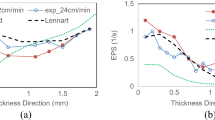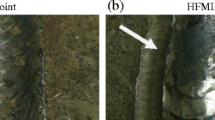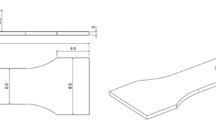Abstract
ICR (Impact Crack-closure Retrofit) treatment was developed for extending fatigue life of cracked steel structures by closing the fatigue crack opening. By applying the ICR treatment to as-welded condition, compressive stress remains at weld toe. Therefore, ICR treatment can be used for the improvement of fatigue strength of welded joint at the same level of the other fatigue strength improved techniques. If a compression overload is subjected after ICR treatment, however, the residual compressive stress at weld toe will shift the tensile stress region. Accordingly, improved fatigue strength of welded joints by ICR treatment will be reduced after the compression overloaded. In order to investigate the effect of the compression overload on fatigue strength improved by ICR treatment, fatigue tests of out-of-plane gusset specimens were carried out. As the results, fatigue strength improved by ICR treatment was hardly reduced under the compression overload condition of nominal stress of −190 MPa.
Similar content being viewed by others
References
Anami, K., Miki, C., Tani, H., and Yamamoto, H. (2000). “Improving fatigue strength of welded joints by hammer peeing and TIG-dressing.” Structural Eng./Earthquake Eng., JSCE, 17(1), pp. 57–68.
Branco, C. M., Infante, V., and Baptista, R. (2004). “Fatigue behavior of welded joints with cracks, repaired by hammer peening.” Fatigue & Fracture of Engineering Materials & Structures, 27(9), pp. 785–798.
Cheng, X., Fisher, J. W., Prask, H. J., Herold, T. G., Yen, B. T., and Roy, S. (2003). “Residual stress modification by post-welded treatment and its beneficial effect on fatigue strength of welded structures.” International Journal of Fatigue, 25, pp. 1259–1269.
Fisher, J. W. (1984). Fatigue and fracture in steel bridges (case studies). Wiley InterScience, USA.
Ishikawa, T., Yamada, K., Takumi Kakiichi, T., and Li, H. (2011). “Extending fatigue life of cracked out-of-plane gusset by ICR treatment.” Structural Eng./Earthquake Eng., 28(1), pp. 21s–28s.
JRA (1997). Fatigue in steel bridges. Japan Road Association, Maruzen, Tokyo, Japan (in Japanese).
JSSC (1995). Fatigue design recommendations for steel structures. Japan Society of Steel Constructions, Gihodo Shuppan, Tokyo, Japan (in Japanese).
Okura, I. (1994). Fatigue in steel bridges. Toyo Shoten, Tokyo, Japan (in Japanese).
Tominaga, T., Matsuoka, K., and Satoh, Y. (2007). “Fatigue improvement method for weld repaired crane runway girder by ultrasonic impact treatment.” Steel Construction Engineering, 14(55), pp. 47–58 (in Japanese).
Yamada, K., Osonoe, T., and Ojio, T. (2007). “Bending fatigue test on welded joint between vertical stiffener and deck plate.” Steel Construction Engineering, 14(55), pp. 1–8 (in Japanese).
Yamada, K., Kakiichi, T., and Ishikawa, T. (2009a). Extending fatigue life of cracked welded joint by impact crack closure retrofit treatment. IIW Document XIII-2289r1-09, International Institute of Welding, Singapore.
Yamada, K., Ishikawa, T., and Kakiichi, T. (2009b). “Extending fatigue durability by closing crack surface.” Doboku Gakkai Ronbunshuu A, 65(4), pp. 961–965 (in Japanese).
Yamada, K., Ishikawa, T., and Kakiichi, T. (2010). A few additional fatigue tests on fatigue cracked fillet welded joint by ICR treatment. IIW Document XIII-2346-10, International Institute of Welding, Istanbul, Turkey.
Author information
Authors and Affiliations
Corresponding author
Additional information
Note.-Discussion open until August 1, 2013. This manuscript for this paper was submitted for review and possible publication on June 28, 2012; approved on February 29, 2013.
Rights and permissions
About this article
Cite this article
Ishikawa, T., Shimizu, M., Tomo, H. et al. Effect of compression overload on fatigue strength improved by ICR treatment. Int J Steel Struct 13, 175–181 (2013). https://doi.org/10.1007/s13296-013-1016-7
Published:
Issue Date:
DOI: https://doi.org/10.1007/s13296-013-1016-7




